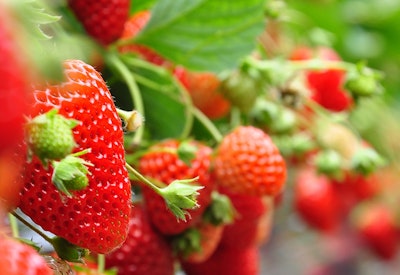 Back to the Be Inspired Blog
Back to the Be Inspired Blog

Grow Your Own Berries in the Bay Area and Enjoy Fresh Smoothies All Year Round
Living in the Bay Area means enjoying a climate that's perfect for growing a variety of delicious berries. Whether you have a sprawling backyard or a modest balcony garden, planting and nurturing strawberries, blueberries, raspberries, blackberries, and boysenberries is easier than you might think. Here’s a simple guide on how to grow these berries, followed by some mouth-watering smoothie recipes to make the most of your harvest.
Growing Your Berries
Strawberries
Tips for Growing Strawberries
- Strawberries prefer well-drained, loamy soil with a slightly acidic pH (between 5.5 and 6.8). Amend heavy clay soils with compost or peat moss to improve drainage.
- Plant strawberry crowns at a depth where the roots are well covered with soil but the crown is just at the surface. Space plants about 12 to 18 inches apart to allow ample room for growth and air circulation.
- Consistent moisture is key to producing juicy strawberries. Water regularly, especially during the dry summer months, to maintain even soil moisture. Avoid overhead watering to reduce the risk of leaf diseases.
- Use straw, pine needles, or black plastic mulch to conserve moisture, suppress weeds, and keep the fruit clean from soil splashes. Mulch also helps to regulate soil temperature.
- Avoid high nitrogen fertilizers late in the season as they can reduce fruit yields and quality.
- Monitor for common pests like slugs, aphids, and spider mites. Use organic controls like diatomaceous earth for slugs or insecticidal soaps for aphids and mites.
Blueberries
Tips for Growing Blueberries
- Blueberries need acidic soil with a pH of 4.5 to 5.5. Test and adjust your soil with sulfur or peat moss to make it acidic. Use raised beds for better drainage if your soil is heavy or clay-like.
- Water them regularly to keep the soil moist but not waterlogged
- While blueberries like full sun, they can benefit from some afternoon shade in hotter parts of the Bay Area.
- Mulch around blueberries with organic materials will help to retain moisture, suppress weeds, and keep the roots cool.
- Watch for birds and pests that might eat the berries and use netting to protect the bushes. Also, keep an eye out for diseases such as powdery mildew or root rot and treat them quickly with the right fungicides or methods.
Raspberries
Tips for Growing Raspberries
- Raspberries thrive in the mild, Mediterranean-like climate of the Bay Area, especially where there is morning sun and some protection from the intense afternoon sun.
- They prefer well-drained, fertile soils with a pH between 5.5 and 6.5. Amend heavy clay soils with compost and sand to improve drainage.
- Consistent moisture is important but avoid waterlogging. Use drip irrigation or soaker hoses to deliver water directly to the roots and keep the leaves dry, which helps prevent leaf diseases.
- Mulch with organic material such as straw or bark mulch to retain soil moisture, suppress weeds, and keep the root system cool.
- Raspberries need regular pruning to stay productive.
- Provide a trellis or support system to keep canes upright and well-spaced. This not only helps in maintaining plant structure but also improves sun exposure and air circulation among the canes.
- Monitor for pests such as aphids and spider mites, and diseases like raspberry rust or botrytis. Use appropriate organic insecticides and fungicides when necessary.
Blackberries
Tips for Growing Blackberries
- Blackberries thrive in full sun but can tolerate partial shade. However, more sun leads to sweeter berries. Select a site that gets at least 6-8 hours of sunlight per day.
- They prefer well-drained, fertile soil with a pH between 5.5 and 7.0. Amend heavy or poorly draining soils with organic matter to improve structure and drainage.
- Plant blackberries 4-6 feet apart in rows 8-10 feet apart. Use a trellis or support to keep the long canes off the ground, which helps increase productivity.
- Consistent watering is crucial, especially during the fruiting period and the hot summer months. Ensure the plants receive 1 to 2 inches of water per week, but avoid overwatering as blackberries do not like soggy soil.
- Use mulch to help retain soil moisture, suppress weeds, and provide a barrier against soil-borne diseases.
- Monitor for pests such as spider mites and aphids, and diseases like rust and powdery mildew. Employ cultural practices such as proper spacing and pruning for good air circulation, which reduces the risk of diseases.
Boysenberries
Tips for Growing Boysenberries
- Boysenberries thrive in the mild, Mediterranean climate of the Bay Area. They need full sun to produce the best fruit but can benefit from some shade during the hottest part of the day.
- They prefer well-drained, fertile soil with a pH between 6.0 and 7.0. Amend the soil with compost or well-rotted manure to improve fertility and drainage.
- Space plants about 4 to 5 feet apart with rows spaced 8 to 10 feet apart. Provide a trellis or wire support system as boysenberries produce long.
- Boysenberries require consistent moisture, especially during fruit development and in the hot summer months. Water regularly to keep the soil moist but not waterlogged.
- Use mulch to retain soil moisture, suppress weeds, and maintain a cool root environment.
- Prune boysenberries annually. Remove any dead or damaged canes and thin the canes to about six to eight vigorous shoots per plant to improve fruit quality and reduce disease pressure.
- Keep an eye out for common pests such as spider mites and aphids, and diseases like botrytis and powdery mildew. Implementing good cultural practices such as proper spacing and pruning, and using organic or recommended pesticides can help manage these issues.
Berry Delicious Smoothie Recipes

Strawberry Sunrise Smoothie:
- 1 cup fresh strawberries
- 1 banana
- 1/2 cup orange juice
- 1/2 cup Greek yogurt
- Ice cubes
Blend all ingredients until smooth and enjoy a refreshing start to your day!

Blueberry Bliss Smoothie:
- 1 cup fresh blueberries
- 1/2 cup almond milk
- 1/2 cup vanilla yogurt
- 1 tbsp honey
- Ice cubes
Combine everything in a blender for a creamy, dreamy blueberry treat.

Raspberry Refresher Smoothie:
- 1 cup fresh raspberries
- 1/2 cup coconut water
- Juice of 1 lime
- 1 tbsp chia seeds
- Ice cubes
Blend until smooth for a tangy, hydrating drink that’s perfect after a workout.

Blackberry Booster Smoothie:
- 1 cup fresh blackberries
- 1/2 cup apple juice
- 1/2 cup spinach leaves
- 1/2 avocado
- Ice cubes
This power-packed smoothie is great for a nutritious breakfast or quick snack.

Blueberry Bliss Smoothie:
- 1 cup fresh blueberries
- 1/2 cup almond milk
- 1/2 cup vanilla yogurt
- 1 tbsp honey
- Ice cubes
Combine everything in a blender for a creamy, dreamy blueberry treat.

Boysenberry Bonanza Smoothie:
- 1 cup fresh boysenberries
- 1/2 cup pomegranate juice
- 1/2 cup cottage cheese
- 1 tbsp flaxseed
- Ice cubes
Blend to a smooth consistency for a uniquely flavorful and protein-rich drink.
Growing berries in the Bay Area is not only rewarding but also adds a delightful burst of flavor to your diet. Enjoy crafting these smoothies with berries straight from your garden and savor the taste of freshness in every sip!

